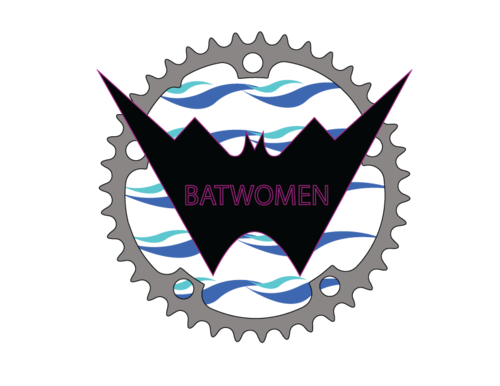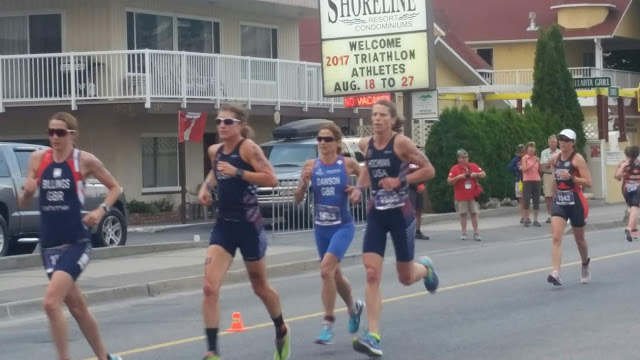I've been thinking a lot recently about Sarah Barber's hip.
In the summer of 2017, I was training for the ITU Duathlon World Championships in Canada. A second ITU World Championships - for Triathlon - was slated for five weeks later in The Netherlands, but I calculated that I had a better chance of winning in Canada. Unlike most triathlons, these races are draft-legal, meaning athletes are allowed to draft during the bike leg, dramatically changing the strategic approach to the race. If you want to stand on the podium, you have to finish the first leg - a run in duathlon and a swim in triathlon - with the fastest athletes to be part of the lead bike pack. Working together with other riders conserves energy and sets up the race to be won or lost in the final run. If you don't make it into the lead bike pack, you burn too many matches trying to catch up, leaving nothing for the run.
The swim is my weakest leg. If I wanted to win a World Championship, I was more likely to do it in Canada.
During the month before the race, I mined the internet for information on the women's field at Worlds. The ITU splits the women's field into under- and over-40s; I was searching for a 40+ American woman who could run a little faster than I could with whom I could work in a bike pack, sharing the pull and managing what might be a hostile and non-cooperative group of racers. Having never raced at Worlds, I didn't really know what I was doing; I was just following a pragmatic process to put together the fastest race I could, embracing the risk inherent of feeling my way in the dark.
Enter Sarah Barber.
Sarah is from Idaho. Cat 2 (wicked-fast) cyclist and mid-19 minute 5K-er. About ten years younger than I am. She'd won the Duathlon National Championships in June of 2017 running away. A wee bit intimidated, I stalked her on Facebook and laid out my rationale for racing together in Canada. Sarah was tentative at best; guarded at worst. She responded that she did not want to feel beholden to someone else and that races take on a life of their own. But she agreed to continue the conversation when we both got to Canada. Feeling a little crestfallen, I went back to all my data to keep hunting. There was no one else; Sarah was the one.
A few days before the race in Canada we spoke again. We agreed that although races can go a hundred different ways once they start, we'd see where we were on the bike leg and work together if possible. We both guessed that the first 5K run would go out at a blistering pace; my goal was to stick with her as long as possible, so we would come into the run-bike transition together. To do this, I would have to run 19:30, or 6:17 mile pace. I had never run that fast in my life.
It was time to start thinking about Sarah Barber's hip.
During the days before the race, I scheduled two long blocks of time for myself to walk through the race in my head. I sat in the back garden of our airbnb in Penticton, going through every detail of race day, from breakfast to finish line, rehearsing how I wanted to feel, where I wanted to be, and what I would do when things went wrong. I rehearsed it over and over again, seeing and feeling myself through the race as viscerally as if I'd already pinned a number to my race kit. The lynchpin to a successful race? Staying on Sarah Barber's hip. For 19:30, it would have to be my whole world.
By the time I arrived at the starting line, my mind was clear. Life slowed down and narrowed to a tunnel. It's easy when you only have one thing to think about. There's not a lot of noise if you can distill your entire purpose, in a moment, to the singular task of following someone's hip.
Lap 1. Sarah and I running just off the leaders. The woman I would eventually have to tackle head-to-head in the second run is Phillips, from the U.K., leading the front pack.
As we started to pass the slower runners from the younger wave before us, Sarah didn't give me much room. Or maybe she didn't know which side I was on. Nothing was going to shake me off that hip, so this poor U.S. woman got an elbow so that I could squeeze through.
300m from the run-bike transition, I couldn't hold on any longer. But it was enough. Sarah's hip had served its purpose. I ran 19:31. I flew through transition and Sarah, Jacqui and I dropped everyone else on the first climb.
The day ended well.
But the best part? Sarah Barber (and her hip) has become a close friend and confidante. I find that often happens when you race with someone.
Eighteen months have passed, but from time to time, I remember the clarity of those 19 minutes. The goal was to win the World Championships. But unless I could break that goal into specific, intentional and achievable steps, I'd lack the roadmap necessary to stand on the top of the podium. There were other race objectives as well - using the massive hill on the 2 lap course to drop other athletes, risking speed on the round-about and 90 degree turn into transition to pass more timid riders, capitalizing on transition speed to gain placement - these and others were strategies that had been considered, examined, and included in a carefully constructed plan intended to give me the best opportunity to reach the goal of winning the World Championship.
Kikkan Randall, five time Olympian and recent winner of America's first-ever Nordic skiing gold medal, remembers clearly the conversation she had with her coaches after her first Olympics at age 19. She finished 46th in 2002 at Salt Lake City; she wanted to win a gold medal. Her coaches laid out a ten year plan to get her on the podium at a World Cup. Ten years. Just to medal at a World Cup. It ended up taking 16 years to win an Olympic gold. But she had a plan with specific steps; her job was patiently execute.
The lesson of Sarah Barber's hip and Kikkan Randall's gold isn't limited to elite athletics. It applies to all of us. Whenever we have a goal, we can break it down into definable, achievable pieces, and then chase those pieces one at a time.
The challenge in real life, for many of us, is to identify the steps. It's easy in athletics. But what happens when you can see the goal, but you can't figure out how to get there?
Slow down. Think. Talk to your closest friends. Identify your resources. Mine the internet. Research the possibilities. Dive enthusiastically into rabbit holes. Be pragmatic. Make lists. Think big. Be brave and deliberate. Consider what could do wrong, then let it go.
Take risks. There may only be one chance to go for the top step at the World Championships. Do you want to wonder later what might have happened if you hadn't played it safe?










